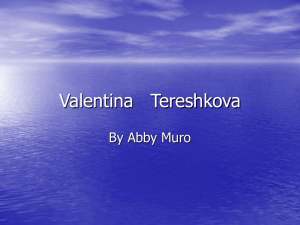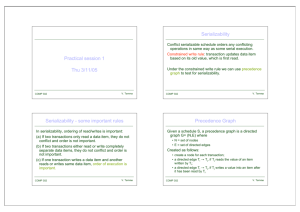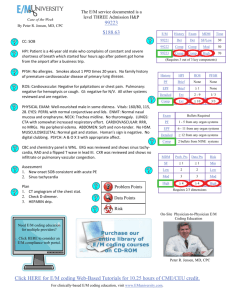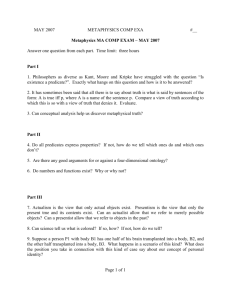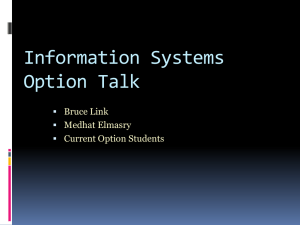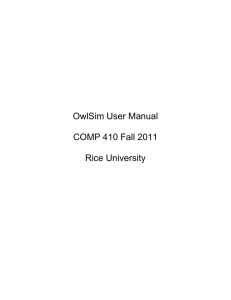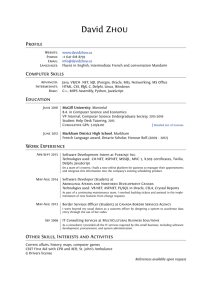Object Oriented Databases
advertisement
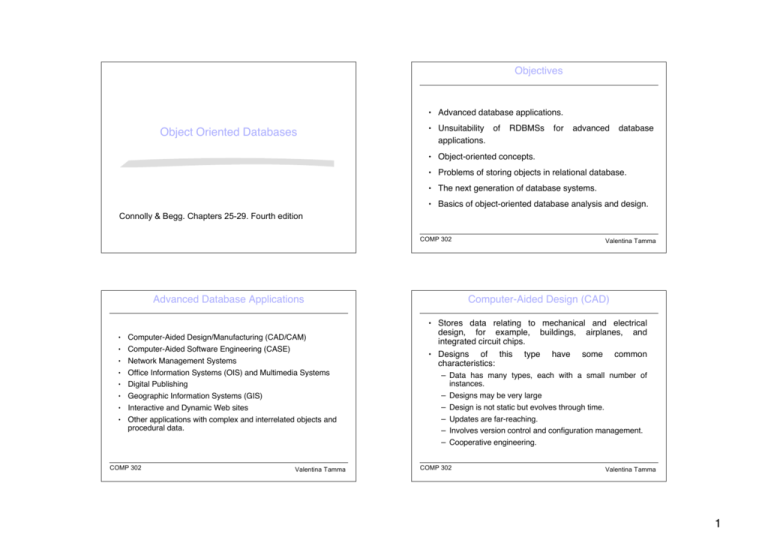
Objectives
• Advanced database applications.
Object Oriented Databases
• Unsuitability
of
RDBMSs
for
advanced
database
applications.
• Object-oriented concepts.
• Problems of storing objects in relational database.
• The next generation of database systems.
• Basics of object-oriented database analysis and design.
Connolly & Begg. Chapters 25-29. Fourth edition
COMP 302
Advanced Database Applications
Valentina Tamma
Computer-Aided Design (CAD)
• Stores data relating to mechanical and electrical
•
•
•
•
•
•
•
•
Computer-Aided Design/Manufacturing (CAD/CAM)
Computer-Aided Software Engineering (CASE)
Network Management Systems
Office Information Systems (OIS) and Multimedia Systems
Digital Publishing
Geographic Information Systems (GIS)
Interactive and Dynamic Web sites
Other applications with complex and interrelated objects and
procedural data.
COMP 302
Valentina Tamma
design, for example, buildings, airplanes, and
integrated circuit chips.
• Designs of this type have some common
characteristics:
– Data has many types, each with a small number of
instances.
– Designs may be very large
– Design is not static but evolves through time.
– Updates are far-reaching.
– Involves version control and configuration management.
– Cooperative engineering.
COMP 302
Valentina Tamma
1
Network Management Systems
Advanced Database Applications
• Coordinate
• Computer-Aided Manufacturing (CAM)
–
Stores similar data to CAD, plus data about discrete
production.
• Computer-Aided Software Engineering (CASE)
–
Stores data about stages of software development lifecycle.
COMP 302
Valentina Tamma
delivery of communication
across a computer network.
• Perform such tasks as network path management,
problem management, and network planning.
• Systems handle complex data and require real-time
performance and continuous operation.
• To route connections, diagnose problems, and
balance loadings, systems have to be able to move
through this complex graph in real-time.
COMP 302
Office Information Systems (OIS) and Multimedia
Systems
• Stores data relating to computer control of information
in a business, including electronic mail, documents,
invoices, and so on.
• Modern
systems now handle free-form text,
photographs, diagrams, audio and video sequences.
• Documents may have specific structure, perhaps
described using
HTML, or XML.
COMP 302
mark-up language such as SGML,
Valentina Tamma
services
Valentina Tamma
Digital Publishing
• Becoming possible to store books, journals, papers,
and articles electronically and deliver them over highspeed networks to consumers.
• As with OIS, digital publishing is being extended to
handle multimedia documents consisting of text,
audio, image, and video data and animation.
• Amount of information available to be put online is in
the order of petabytes (1015 bytes), making them
largest databases DBMS has ever had to manage.
COMP 302
Valentina Tamma
2
Geographic Information Systems (GIS)
Interactive and Dynamic Web Sites
• Consider online catalog for selling clothes. Web site
• GIS
database stores spatial and temporal
information, such as that used in land management
and underwater exploration.
• Much of data is derived from survey and satellite
photographs, and tends to be very large.
• Searches may involve identifying features based, for
example, on shape, color, or texture,
advanced pattern-recognition techniques.
COMP 302
using
Valentina Tamma
maintains a set of preferences for previous visitors
and allows a visitor to:
– obtain 3D rendering of any item based on color, size,
fabric, etc.;
– modify rendering to account for movement, illumination,
backdrop, occasion, etc.;
– select accessories to go with the outfit, from items
presented in a sidebar;
• Need
to handle multimedia content and to
interactively modify display based on user
preferences and user selections. Added complexity of
providing 3D rendering.
COMP 302
Weaknesses of RDBMSs
Valentina Tamma
Weaknesses of RDBMSs
• Poor Representation of “Real World” Entities
– Normalization leads to relations that do not correspond to
• Poor Support for Integrity and Enterprise Constraints
• Limited Operations
entities in “real world”.
– RDBMs only have a fixed set of operations which cannot be
• Semantic Overloading
extended.
– Relational model has only one construct for representing data
and data relationships: the relation.
• Difficulty Handling Recursive Queries
– Extremely difficult to produce recursive queries.
– Extension proposed to relational algebra to handle this type of
– Relational model is semantically overloaded.
query is unary transitive (recursive) closure operation.
• Homogeneous Data Structure
– Relational model assumes both horizontal and vertical
homogeneity.
– Many RDBMSs now allow Binary Large Objects (BLOBs).
COMP 302
Valentina Tamma
COMP 302
Valentina Tamma
3
Example - Recursive Query
Weaknesses of RDBMSs
• Impedance Mismatch
– Most DMLs lack computational completeness.
– To overcome this, SQL can be embedded in a high-level 3rd
Generation Language.
– This produces an impedance mismatch - mixing different
programming paradigms.
– Estimated that as much as 30% of programming effort and
code space is expended on this type of conversion.
SELECT managerstaffNo
FROM Staff
WHERE staffNo=‘S005’
UNION
SELECT managerstaffNo
FROM Staff
WHERE staffNo=
(SELECT managerstaffNo
FROM Staff
WHERE staffNo=‘S005’)
COMP 302
• Other Problems with RDBMSs
– Transactions are generally short-lived and concurrency
control protocols not suited for long-lived transactions.
– Schema changes are difficult.
– RDBMSs are poor at navigational access.
Valentina Tamma
COMP 302
Valentina Tamma
Abstraction
Object-Oriented Concepts
• Abstraction, encapsulation, information hiding.
• Objects and attributes.
• Process of identifying essential aspects of an entity
and ignoring unimportant properties.
• Concentrate on what an object is and what it does,
• Object identity.
before deciding how to implement it.
• Methods and messages.
• Classes, subclasses, superclasses, and inheritance.
• Overloading.
• Polymorphism and dynamic binding.
COMP 302
Valentina Tamma
COMP 302
Valentina Tamma
4
Encapsulation and Information Hiding
Encapsulation
– Object contains both data structure and set of
operations used to manipulate it.
Information Hiding
•
Uniquely identifiable entity that contains both the
attributes that describe the state of a real-world object
and the actions associated with it.
– Definition very similar to that of an entity, however, object
– Separate external aspects of an object from its
internal details, which are hidden from outside.
•
Object
encapsulates both state and behavior; an entity only models
state.
Allows internal details of an object to be changed without
affecting applications that use it, provided external details
remain same.
Provides data independence.
COMP 302
Valentina Tamma
COMP 302
Attributes
Valentina Tamma
Object Identity
Contain current state of an object.
• Attributes can be classified as simple or complex.
• Simple attribute can be a primitive type such as
Object identifier (OID) assigned to object when it is
created that is:
– System-generated.
integer, string, etc., which takes on literal values.
• Complex attribute can contain collections and/or
references.
– Unique to that object.
• Reference attribute represents relationship.
– Invisible to the user (ideally).
– Invariant.
– Independent of the values of its attributes (that is, its state).
• An object that contains one or more complex attributes
is called a complex object.
COMP 302
Valentina Tamma
COMP 302
Valentina Tamma
5
Object Identity - Implementation
Object Identity - Implementation
• In RDBMS, object identity is value-based: primary key
• Programming languages use variable names and
is used to provide uniqueness.
• Primary keys do not provide type of object identity
required in OO systems:
pointers/virtual memory addresses,
compromise object identity.
which
also
• In C/C++, OID is physical address in process memory
– key only unique within a relation, not across entire system;
– key generally chosen from attributes of relation, making it
dependent on object state.
space, which is too small - scalability requires that
OIDs be valid across storage volumes, possibly across
different computers.
• Further, when object is deleted, memory is reused,
which may cause problems.
COMP 302
Valentina Tamma
COMP 302
Advantages of OIDs
Valentina Tamma
Methods and Messages
• They are efficient.
Method
– Defines behavior of an object, as a set of encapsulated
• They are fast.
functions.
• They cannot be modified by the user.
• They are independent of content.
Message
– Request from one object to another asking second object to
execute one of its methods.
COMP 302
Valentina Tamma
COMP 302
Valentina Tamma
6
Object Showing Attributes and Methods
COMP 302
Valentina Tamma
Class
Example of a Method
COMP 302
Valentina Tamma
Class Instance Share Attributes and Methods
Blueprint for defining a set of similar objects.
• Objects in a class are called instances.
• Class is also an object with own class attributes and
class methods.
•
Class different from type
COMP 302
Valentina Tamma
COMP 302
Valentina Tamma
7
Subclasses, Superclasses, and Inheritance
Inheritance allows one class of objects to be defined
as a special case of a more general class.
• Special cases are subclasses and more general
cases are superclasses.
• Process of forming a superclass is generalization;
forming a subclass is specialization.
• Subclass inherits all properties of its superclass and
can define its own unique properties.
• Subclass can redefine inherited methods.
COMP 302
Valentina Tamma
Subclasses, Superclasses, and Inheritance
• All instances of subclass are also instances of
superclass.
• Principle of substitutability states that instance of
subclass can be used whenever method/construct
expects instance of superclass.
• Relationship between subclass and superclass known
as A KIND OF (AKO) relationship.
• Four types of inheritance: single, multiple, repeated,
and selective.
COMP 302
Single Inheritance
COMP 302
Valentina Tamma
Multiple Inheritance
Valentina Tamma
COMP 302
Valentina Tamma
8
Repeated Inheritance
Overriding, Overloading, and Polymorphism
Overriding
– Process of redefining a property within a subclass.
Overloading
– Allows name of a method to be reused with a class or
across classes.
Polymorphism
– Means ‘many forms’. Three types: operation, inclusion,
and parametric.
COMP 302
Valentina Tamma
COMP 302
Example of Overriding
Valentina Tamma
Overloading Print Method
• Might define method in Staff class to increment salary
based on commission:
method void giveCommission(float branchProfit) {
salary = salary + 0.02 * branchProfit; }
• May wish to perform different calculation for commission
in Manager subclass:
method void giveCommission(float branchProfit) {
salary = salary + 0.05 * branchProfit; }
COMP 302
Valentina Tamma
COMP 302
Valentina Tamma
9
Dynamic Binding
Complex Objects
An object that consists of subobjects but is viewed as
a single object.
Runtime process of selecting appropriate method
based on an object’s type.
• Objects
participate
relationship.
• With list consisting of an arbitrary number of objects
from the Staff hierarchy, we can write:
A-PART-OF
(APO)
object, accessed by complex object’s methods.
• Or have its own independent existence, and only an
• and runtime system will determine which print()
invoke
depending
COMP 302
on
the
OID is stored in complex object.
object’s
Valentina Tamma
COMP 302
Object-Oriented Languages
Object-oriented concepts can be used in a database system
in different ways
– Object-orientation can be used as a design tool, and be encoded
into, for example, a relational database
Valentina Tamma
Persistent Programming Languages
•
Persistent Programming languages allow objects to be created and stored in
a database, and used directly from a programming language
– allow data to be manipulated directly from the programming language
No need to go through SQL.
– No need for explicit format (type) changes
– Analogous to modeling data with E-R diagram and then converting
to a set of relations)
format changes are carried out transparently by system
Without a persistent programming language, format changes
becomes a burden on the programmer
– The concepts of object orientation can be incorporated into a
– More code to be written
programming language that is used to manipulate the database.
Object-relational systems – add complex types and object-
orientation to relational language.
Persistent programming languages – extend object-oriented
– More chance of bugs
– allow objects to be manipulated in-memory
Valentina Tamma
no need to explicitly load from or store to the database
– Saved code, and saved overhead of loading/storing large amounts
of data
programming language to deal with databases by adding
concepts such as persistence and collections.
COMP 302
a
• Contained object can be encapsulated within complex
list[i]. print
method to
(sub)type.
in
COMP 302
Valentina Tamma
10
Persistent Programming Languages
• Drawbacks of persistent programming languages
– Due to power of most programming languages, it is easy to make
programming errors that damage the database.
– Complexity of languages makes automatic high-level optimization
more difficult.
– Do not support declarative querying as well as relational
databases
Storing Objects in Relational Databases
1. One approach to achieving persistence with an OOPL is
to use an RDBMS as the underlying storage engine.
2. Requires mapping class instances (i.e. objects) to one
or more tuples distributed over one or more relations.
3. To handle class hierarchy, have two basics tasks to
perform:
(1) design relations to represent class hierarchy;
(2) design how objects will be accessed:
a) Writing Code to decompose the objects into tuples and store
them in relations
b) Writing
code to read tuples from the relations and
reconstruct the objects
COMP 302
Valentina Tamma
COMP 302
Storing Objects in Relational Databases
Valentina Tamma
Mapping Classes to Relations
Number of strategies for mapping classes to relations, although
each results in a loss of semantic information (usually on the
hierarchical structure).
(1) Map each class or subclass to a relation:
Staff (staffNo, fName, lName, position, sex, DOB, salary)
Manager (staffNo, bonus, mgrStartDate)
SalesPersonnel (staffNo, salesArea, carAllowance)
Secretary (staffNo, typingSpeed)
The datatype of each attribute must be supported by the RDBMS!
COMP 302
Valentina Tamma
COMP 302
Valentina Tamma
11
Mapping Classes to Relations
(2) Map each subclass to a relation
Next Generation Database Systems
First Generation DBMS: Network and Hierarchical
Manager (staffNo, fName, lName, position, sex, DOB, salary, bonus, mgrStartDate)
– Required complex programs for even simple queries.
SalesPersonnel (staffNo, fName, lName, position, sex, DOB, salary, salesArea,
carAllowance)
– Minimal data independence.
Secretary (staffNo, fName, lName, position, sex, DOB, salary, typingSpeed)
– No widely accepted theoretical foundation.
Second Generation DBMS: Relational DBMS
(3) Map the hierarchy to a single relation
Staff (staffNo, fName, lName, position, sex, DOB, salary, bonus, mgrStartDate,
salesArea, carAllowance, typingSpeed, typeFlag)
– Helped overcome these problems.
Third Generation DBMS: OODBMS and ORDBMS.
TypeFlag is used to distinguish which type each tuple is
(1 Manager, 2 SalesStaff,…)
COMP 302
Valentina Tamma
COMP 302
Valentina Tamma
History of Data Models
Object-Oriented DBMSs – Concepts
and Design
Connolly and Begg, Chapter 26
COMP 302
Valentina Tamma
12
Object-Oriented Database Design
Relationships
• Relationships represented using reference attributes,
typically implemented using OIDs.
• Consider how to represent following binary relationships
according to their cardinality:
– 1:1
– 1:*
– *:*.
COMP 302
Valentina Tamma
1:1 Relationship Between Objects A and B
COMP 302
Valentina Tamma
1:* Relationship Between Objects A and B
• Add reference attribute to B and attribute containing set
of references to A.
• Add
reference attribute to A and, to maintain
referential integrity, reference attribute to B.
COMP 302
Valentina Tamma
COMP 302
Valentina Tamma
13
*:* Relationship Between Objects A and B
*:* Relationships
• Add attribute containing set of references to each
object.
• For relational database design, would decompose *:N
into two 1:* relationships linked by intermediate entity.
Can also represent this model in an ODBMS.
COMP 302
Valentina Tamma
COMP 302
Alternative Design for *:* Relationships
Valentina Tamma
Referential Integrity
Several techniques to handle referential integrity:
• Do not allow user to explicitly delete objects.
– System is responsible for “garbage collection”.
• Allow user to delete objects when they are no longer
required.
– System may detect invalid references automatically and
set reference to NULL or disallow the deletion.
COMP 302
Valentina Tamma
COMP 302
Valentina Tamma
14
Referential Integrity
Behavioral Design
• Allow
user to modify and delete objects
relationships when they are no longer required.
and
– System automatically maintains the integrity of objects.
– Inverse attributes can be used to maintain referential
integrity.
• EER approach must be supported with technique that
identifies behavior of each class (processing
requirements)
• Involves identifying:
– public methods: visible to all users
– private methods: internal to class.
• Three types of methods:
– constructors and destructors
– access
– transform.
COMP 302
Valentina Tamma
COMP 302
Identifying Methods
Behavioral Design - Methods
• Constructor - creates new instance of class (with a
unique OID).
• Several methodologies for identifying methods, typically
combine following approaches:
• Destructor - deletes class instance no longer required.
• Access - returns value of one or more attributes (Get).
Can return a single value or a collection.
• Transform - changes state of class instance (Put).
COMP 302
Valentina Tamma
Valentina Tamma
– Identify classes and determine methods that may be
usefully provided for each class.
– Decompose application in top-down fashion and
determine methods required to provide required
functionality.
COMP 302
Valentina Tamma
15
Reading material
Objectives
• Object oriented analysis and design with UML: Connolly
and Begg, 4th edition, 25.7
• Framework for an OODM.
• Basics of persistent programming languages.
• Slides together with the notes on OO
• Main points of OODBMS Manifesto.
• Main strategies for developing an OODBMS.
• Single-level v. two-level storage models.
• Pointer swizzling.
COMP 302
Valentina Tamma
COMP 302
Objectives
Valentina Tamma
Object-Oriented Data Model
No one agreed object data model. One definition:
• How an OODBMS accesses records.
Object-Oriented Data Model (OODM)
• Persistent schemes.
• Advantages
and
disadvantages
of
orthogonal
persistence.
– Data model that captures semantics of objects supported
in object-oriented programming.
Object-Oriented Database (OODB)
• Issues underlying OODBMSs.
• Advantages and disadvantages of OODBMSs.
– Persistent and sharable collection of objects defined by an
ODM.
Object-Oriented DBMS (OODBMS)
– Manager of an ODB.
COMP 302
Valentina Tamma
COMP 302
Valentina Tamma
16
Object-Oriented Data Model
Object-Oriented Data Model
• Zdonik and Maier present a threshold model that an
•
OODBMS must, at a minimum, satisfy:
1. OO = ADTs + Inheritance + Object identity
2. OODBMS = OO + Database capabilities.
– It must provide database functionality.
•
– It must support object identity.
•
Khoshafian and Abnous define OODBMS as:
Parsaye et al. gives:
– It must provide encapsulation.
1. High-level query language with query optimization.
– It must support objects with complex state.
2. Support for persistence, atomic transactions: concurrency
and recovery control.
Inheritance useful but not essential
3. Support for complex object storage, indexes, and access
methods.
4. OODBMS = OO system + (1), (2), and (3).
COMP 302
Valentina Tamma
Commercial OODBMSs
COMP 302
Valentina Tamma
Origins of the Object-Oriented Data Model
• GemStone from Gemstone Systems Inc.,
• Objectivity/DB from Objectivity Inc.,
• ObjectStore from Progress Software Corp.,
• Ontos from Ontos Inc.,
• FastObjects from Poet Software Corp.,
• Jasmine from Computer Associates/Fujitsu,
• Versant from Versant Corp.
COMP 302
Valentina Tamma
COMP 302
Valentina Tamma
17
Persistent Programming Languages (PPLs)
• Language
that provides users with ability to
(transparently) preserve data across successive
executions of a program, and even allows such data to
be used by many different programs.
• In contrast, database programming language (e.g.
SQL) differs by its incorporation of features beyond
persistence, such as transaction management,
concurrency control, and recovery.
COMP 302
Valentina Tamma
Persistent Programming Languages (PPLs)
• PPLs eliminate impedance mismatch by extending
programming language with database capabilities.
– In PPL, language’s type system provides data model,
containing rich structuring mechanisms.
• In some PPLs procedures are ‘first class’ objects and
are treated like any other object in language.
– Procedures are assignable, may be result of expressions,
other procedures or blocks, and may be elements of
constructor types.
– Procedures can be used to implement ADTs.
COMP 302
Persistent Programming Languages (PPLs)
• PPL also maintains same data representation in
memory as in persistent store.
Valentina Tamma
OODBMS Manifesto
• Complex objects must be supported.
• Object identity must be supported.
– Overcomes difficulty and overhead of mapping between
the two representations.
• Addition of (transparent) persistence into a PPL is
important enhancement to IDE, and integration of two
paradigms provides more functionality and semantics.
• Encapsulation must be supported.
• Types or Classes must be supported.
• Types or Classes must be able to inherit from their
ancestors.
• Dynamic binding must be supported.
• The DML must be computationally complete (general
purpose programming language).
COMP 302
Valentina Tamma
COMP 302
Valentina Tamma
18
OODBMS Manifesto
OODBMS Manifesto
• The set of data types must be extensible.
• The
manifesto
features:
• Data persistence must be provided.
• The DBMS must be capable of managing very large
databases.
• The DBMS must support concurrent users.
• DBMS must be able to recover from hardware/software
failures.
• DBMS must provide a simple way of querying data.
COMP 302
Valentina Tamma
Alternative Strategies for Developing an OODBMS
• Extend existing object-oriented programming language.
– GemStone extended Smalltalk.
• Provide extensible OODBMS library.
– Approach taken by Ontos, Versant, and ObjectStore.
• Embed OODB language constructs in a conventional
host language.
proposes
the
following
optional
– Multiple inheritance, type checking and type inferencing,
distribution across a network, design transactions and
versions.
• No direct mention of support for security, integrity,
views or even a declarative query language.
COMP 302
Valentina Tamma
Alternative Strategies for Developing an OODBMS
• Extend
existing database
oriented capabilities.
language
with
object-
– Approach being pursued by RDBMS and OODBMS
vendors.
– Ontos and Versant provide a version of OSQL.
• Develop a novel database data model/language.
– Approach taken by O2,which has extensions for C.
COMP 302
Valentina Tamma
COMP 302
Valentina Tamma
19
Single-Level v. Two-Level Storage Model
Performance vs ease of use
Single-Level v. Two-Level Storage Model
• With a traditional DBMS, programmer has to:
– Decide when to read and update objects.
built-in
– Write code to translate between application’s object
model and the data model of the DBMS.
number of applications now require
functionality from both database systems and
programming languages.
– Perform additional type-checking when object is read
back from database, to guarantee object will conform to
its original type.
• Traditional
programming languages
support for many database features.
lack
• Increasing
• Such applications need to store and retrieve large
amounts of shared, structured data.
COMP 302
Valentina Tamma
COMP 302
Single-Level v. Two-Level Storage Model
Valentina Tamma
Two-Level Storage Model for RDBMS
• Difficulties occur because conventional DBMSs have
two-level storage model: storage model in memory,
and database storage model on disk.
• In contrast, OODBMS gives illusion of single-level
storage model, with similar representation in both
memory and in database stored on disk.
– Requires clever management of representation of
objects in memory and on disk (called “pointer
swizzling”).
COMP 302
Valentina Tamma
COMP 302
Valentina Tamma
20
Single-Level Storage Model for OODBMS
Pointer Swizzling Techniques
The action of converting object identifiers (OIDs) to
main memory pointers.
• Logical OIDs vs Physical OIDs, both different from in
memory pointers
• Aim is to optimize access to objects.
• Should be able to locate any referenced objects on
secondary storage using their OIDs.
• Once objects have been read into cache, want to
record that objects are now in memory to prevent them
from being retrieved again.
COMP 302
Valentina Tamma
COMP 302
Pointer Swizzling Techniques
• Could hold lookup table that maps OIDs to memory
pointers (e.g. using hashing), but this is slow
• Pointer swizzling attempts to provide a more efficient
strategy by storing memory pointers in the place of
referenced OIDs, and vice versa when the object is
written back to disk.
Valentina Tamma
No Swizzling
• Easiest implementation is not to do any swizzling.
• Objects faulted into memory, and handle passed to
application containing object’s OID.
• OID is used every time the object is accessed.
• System must maintain some type of lookup table Resident Object Table (ROT) - so that object’s virtual
memory pointer can be located and then used to
access object.
• Inefficient if same objects are accessed repeatedly.
• Acceptable if objects only accessed once.
COMP 302
Valentina Tamma
COMP 302
Valentina Tamma
21
Resident Object Table (ROT)
Object Referencing
• Need to distinguish between resident and non-resident
objects.
• Most techniques variations of edge marking or node
marking.
• Virtual memory as a directed graph where objects are
nodes, and references the directed edges
• Edge marking marks every object pointer with a tag bit:
– if bit set, reference is to memory pointer;
– else, still pointing to OID and needs to be swizzled when
object it refers to is faulted into.
COMP 302
Valentina Tamma
COMP 302
Valentina Tamma
Object Referencing
Hardware-Based Schemes
• Node marking requires that all object references are
• Use virtual memory access protection violations to
immediately converted to virtual memory pointers
when object is faulted into memory.
• Use standard virtual memory hardware to trigger
• First
approach is software-based technique but
second can be implemented using software or
hardware-based techniques.
COMP 302
Valentina Tamma
detect accesses of non-resident objects.
transfer of persistent data from disk to memory.
• Once page has been faulted in, objects are accessed
via normal virtual memory pointers and no further
object residency checking is required.
• Avoids overhead of residency checks incurred by
software approaches.
COMP 302
Valentina Tamma
22
Pointer Swizzling - Other Issues
Copy versus In-Place Swizzling
• Three other issues that affect swizzling techniques:
• When faulting objects in, data can either be copied into
application’s local object cache or accessed in-place
within object manager’s database cache .
• Copy swizzling may be more efficient as, in the worst
case, only modified objects have to be swizzled back
to their OIDs.
• In-place may have to unswizzle entire page of objects
if one object on page is modified.
– Copy versus In-Place Swizzling.
– Eager versus Lazy Swizzling.
– Direct versus Indirect Swizzling.
COMP 302
Valentina Tamma
COMP 302
Eager versus Lazy Swizzling
Direct versus Indirect Swizzling
• Moss defines eager swizzling as swizzling all OIDs for
persistent objects on all data pages used
application, before any object can be accessed.
by
• More
relaxed definition restricts swizzling to all
persistent OIDs within object the application wishes to
access.
• Lazy swizzling only swizzles pointers as they are
accessed or discovered.
COMP 302
Valentina Tamma
Valentina Tamma
• Only an issue when swizzled pointer can refer to object
that is no longer in virtual memory.
• With
direct swizzling, virtual memory pointer of
referenced object is placed directly in swizzled pointer.
• With indirect swizzling, virtual memory pointer is placed
in an intermediate object, which acts as a placeholder
for the actual object.
– Allows objects to be uncached without requiring swizzled
pointers to be unswizzled.
COMP 302
Valentina Tamma
23
Accessing an Object with a RDBMS
COMP 302
Valentina Tamma
Accessing an Object with an OODBMS
COMP 302
Persistent Schemes
Valentina Tamma
Checkpointing
• Consider three persistent schemes to make objects
persistent:
• Copy all or part of program’s address space to
secondary storage.
• If complete address space saved, program can restart
– Checkpointing.
from checkpoint.
– Serialization.
• In other cases, only program’s heap saved.
– Explicit Paging.
• Two main drawbacks:
• Note, persistence can also be applied to (object) code
and to the program execution state.
COMP 302
Valentina Tamma
– Can only be used by program that created it.
– May contain large amount of data that is of no use in
subsequent executions.
COMP 302
Valentina Tamma
24
Serialization
Serialization
• Two inherent problems:
• Copy closure of a data structure to disk.
• Write on a data value may involve traversal of graph of
objects reachable from the value, and writing of
flattened version of structure to disk.
– Does not preserve object identity.
– Not incremental, so saving small changes to a large data
structure is not efficient.
• Reading back flattened data structure produces new
copy of original data structure.
• Sometimes called serialization, pickling, or in a
distributed computing context, marshaling.
COMP 302
Valentina Tamma
Explicit Paging
Valentina Tamma
Explicit Paging - Reachability-Based Persistence
• Explicitly ‘page’ objects between application heap and
persistent store.
• Object will persist if it is reachable from a persistent root
object.
• Usually requires conversion of object pointers from
disk-based scheme to memory-based scheme.
• Two common methods for creating/updating persistent
objects:
• Programmer does not need to decide at object creation
time whether object should be persistent.
• Object can become persistent by adding it to the
reachability tree.
– Reachability-based.
– Allocation-based.
COMP 302
COMP 302
• Maps
well onto language that contains garbage
collection mechanism (e.g. Smalltalk or Java).
Valentina Tamma
COMP 302
Valentina Tamma
25
Explicit Paging - Allocation-Based Persistence
• Object only made persistent if it is explicitly declared
as such within the application program.
• By class
– Class is statically declared to be persistent and all
instances made persistent when they are created.
– Class may be subclass of system-supplied persistent
class.
• Can be achieved in several ways:
– By class.
• By explicit call
– Object may be specified as persistent when it is created
or dynamically at runtime.
– By explicit call.
COMP 302
Explicit Paging - Allocation-Based Persistence
Valentina Tamma
COMP 302
Orthogonal Persistence
Persistence Independence
• Persistence of object independent of how program
• Three fundamental principles:
manipulates that object.
– Persistence independence.
• Conversely, code fragment independent of persistence
of data it manipulates.
– Data type orthogonality.
– Transitive persistence (originally referred to as
‘persistence identification’ but ODMG term ‘transitive
persistence’ used here).
COMP 302
Valentina Tamma
Valentina Tamma
• Should be possible to call function with its parameters
sometimes objects with long term persistence and
sometimes only transient.
• Programmer does not need to control movement of
data between long-term and short-term storage.
COMP 302
Valentina Tamma
26
Data Type Orthogonality
Transitive Persistence
• All data objects should be allowed full range of
• Choice of how to identify and provide persistent objects
persistence irrespective of their type.
• No special cases where object is not allowed to be
long-lived or is not allowed to be transient.
at language level is independent of the choice of data
types in the language.
• Technique that is now widely used for identification is
• In some PPLs, persistence is quality attributable to
reachability-based.
only subset of language data types.
COMP 302
Valentina Tamma
Orthogonal Persistence - Advantages
• Improved
programmer
productivity
from
simpler
mechanisms
over
whole
environment.
– System required to test if object must be loaded in from
disk-resident database.
• Although
orthogonal
persistence
promotes
transparency, system with support for sharing among
concurrent processes cannot be fully transparent.
• Support for incremental evolution.
• Automatic referential integrity.
COMP 302
• Some runtime expense in a system where every
pointer reference might be addressing persistent
object.
• Improved maintenance.
protection
Valentina Tamma
Orthogonal Persistence - Disadvantages
semantics.
• Consistent
COMP 302
Valentina Tamma
COMP 302
Valentina Tamma
27
Versions
Versions and Configurations
Allows changes to properties of objects to be managed
so that object references always point to correct object
version.
• Itasca identifies 3 types of versions:
–
Transient Versions.
–
Working Versions.
–
Released Versions.
COMP 302
Valentina Tamma
COMP 302
Versions and Configurations
Valentina Tamma
Schema Evolution
• Some applications require considerable flexibility in
dynamically defining and modifying database schema.
• Typical schema changes:
(1) Changes to class definition:
(a) Modifying Attributes.
(b) Modifying Methods.
COMP 302
Valentina Tamma
COMP 302
Valentina Tamma
28
Schema Evolution
Schema Consistency
(2) Changes to inheritance hierarchy:
1.
Resolution of conflicts caused by multiple
inheritance and redefinition of attributes and
methods in a subclass.
1.1
Rule
of
precedence
of
subclasses over
superclasses.
Rule of precedence between superclasses of a
different origin.
Rule of precedence between superclasses of the
same origin.
(a) Making a class S superclass of a class C.
(b) Removing S from list of superclasses of C.
(c) Modifying order of superclasses of C.
(3) Changes to set of classes, such as creating and
deleting classes and modifying class names.
1.2
1.3
• Changes must not leave schema inconsistent.
COMP 302
Valentina Tamma
COMP 302
Schema Consistency
Schema Consistency
2.
Propagation of modifications to subclasses.
2.1
2.2
Rule for propagation of modifications.
Rule for propagation of modifications in the event
of conflicts.
Rule for modification of domains.
2.3
COMP 302
Valentina Tamma
Valentina Tamma
3.
Aggregation
and
deletion of inheritance
relationships between classes and creation and
removal of classes.
3.1
3.2
3.3
3.4
Rule for inserting superclasses.
Rule for removing superclasses.
Rule for inserting a class into a schema.
Rule for removing a class from a schema.
COMP 302
Valentina Tamma
29
Schema Consistency
Client-Server Architecture
• Three basic architectures:
– Object Server.
– Page Server.
– Database Server.
COMP 302
Valentina Tamma
COMP 302
Object Server
Valentina Tamma
Page and Database Server
• Distribute processing between the two components.
• Typically,
client is responsible for transaction
management and interfacing to programming language.
• Server responsible for other DBMS functions.
• Best for cooperative, object-to-object processing in an
open, distributed environment.
Page Server
• Most database processing is performed by client.
• Server responsible for secondary storage and providing
pages at client’s request.
Database Server
• Most database processing performed by server.
• Client simply passes requests to server, receives
results and passes them to application.
• Approach taken by many RDBMSs.
COMP 302
Valentina Tamma
COMP 302
Valentina Tamma
30
Client-Server Architecture
Architecture - Storing and Executing Methods
• Two approaches:
–
Store methods in external files.
–
Store methods in database.
• Benefits of latter approach:
– Eliminates redundant code.
– Simplifies modifications.
COMP 302
Valentina Tamma
Architecture - Storing and Executing Methods
COMP 302
Valentina Tamma
Architecture - Storing and Executing Methods
– Methods are more secure.
– Methods can be shared concurrently.
– Improved integrity.
• Obviously, more difficult to implement.
COMP 302
Valentina Tamma
COMP 302
Valentina Tamma
31
Benchmarking - Wisconsin benchmark
Benchmarking - Wisconsin benchmark
• Developed to allow comparison of particular DBMS
features.
• Consists of set of tests as a single user covering:
• Original benchmark had 3 relations: one called Onektup
with
1000
tuples,
and
two
Tenktup1/Tenktup2 with 10000 tuples.
others
called
• Generally useful although does not cater for highly
– updates/deletes involving key and non-key attributes;
– projections involving different degrees of duplication in the
attributes and selections with different selectivities on
indexed, non-index, and clustered attributes;
– joins with different selectivities;
skewed attribute distributions and join queries used are
relatively simplistic.
• Consortium
of manufacturers formed Transaction
Processing Council (TPC) in 1988 to create series of
transaction-based test suites to measure database/TP
environments.
– aggregate functions.
COMP 302
Valentina Tamma
TPC Benchmarks
• Intended
• TPC-C replaced TPC-A/B and based on order entry
application.
• TPC-H for ad hoc, decision support environments.
• TPC-R for business reporting within decision support
environments.
a
eCommerce.
COMP 302
Valentina Tamma
Object Operations Version 1 (OO1) Benchmark
• TPC-A and TPC-B for OLTP (now obsolete).
• TPC-W,
COMP 302
as
generic
measure
of
OODBMS
performance. Designed to reproduce operations
common in advanced engineering applications, such as
finding all parts connected to a random part, all parts
connected to one of those parts, and so on, to a depth
of seven levels.
• About 1990, benchmark was run on GemStone, Ontos,
transactional
Web
benchmark
for
Valentina Tamma
ObjectStore, Objectivity/DB, and Versant, and INGRES
and Sybase. Results showed an average 30-fold
performance improvement for OODBMSs over
RDBMSs.
COMP 302
Valentina Tamma
32
Advantages of OODBMSs
Disadvantages of OODBMSs
• Enriched Modeling Capabilities.
• Lack of Universal Data Model.
• Extensibility.
• Lack of Experience.
• Removal of Impedance Mismatch.
• Lack of Standards.
• More Expressive Query Language.
• Query Optimization compromises Encapsulation.
• Support for Schema Evolution.
• Object Level Locking may impact Performance.
• Support for Long Duration Transactions.
• Complexity.
• Applicability to Advanced Database Applications.
• Lack of Support for Views.
• Improved Performance.
• Lack of Support for Security.
COMP 302
Valentina Tamma
COMP 302
Valentina Tamma
UML
• Represents unification and evolution of several
OOAD methods, particularly:
– Booch method,
Additional reading
– Object Modeling Technique (OMT),
– Object-Oriented Software Engineering (OOSE).
• Adopted as a standard by OMG and accepted by
software community as primary notation for modeling
objects and components.
COMP 302
Valentina Tamma
33
UML
UML – Design Goals
• Provide
• Defined
ready-to-use, expressive visual modeling
language so users can develop and exchange
meaningful models.
• Provide extensibility and specialization mechanisms to
extend core concepts.
• The
• Be independent of particular programming languages
as “a standard language for specifying,
constructing, visualizing, and documenting the artifacts
of a software system”.
UML does not prescribe any particular
methodology, but instead is flexible and customizable to
fit any approach and can be used in conjunction with a
wide range of software lifecycles and development
processes.
and development processes.
• Provide a formal basis for understanding the modeling
language.
• Encourage growth of object-oriented tools market.
• Support higher-level development concepts such as
collaborations, frameworks, patterns, and components.
• Integrate best practices.
COMP 302
Valentina Tamma
COMP 302
UML - Diagrams
•
•
UML – Object Diagrams
• Model instances of classes and used to describe
Structural:
–
–
–
–
Valentina Tamma
system at a particular point in time.
• Can be used to validate class diagram with “real
world” data and record test cases.
class diagrams
object diagrams
component diagrams
deployment diagrams.
Behavioral:
– use case diagrams
–
–
–
–
sequence diagrams
collaboration diagrams
statechart diagrams
activity diagrams.
COMP 302
Valentina Tamma
COMP 302
Valentina Tamma
34
UML – Component Diagrams
UML – Deployment Diagrams
• Depict configuration of run-time system, showing
• Describe
organization and dependencies among
physical software components, such as source code,
run-time (binary) code, and executables.
COMP 302
Valentina Tamma
hardware nodes, components that run on these
nodes, and connections between nodes.
COMP 302
Valentina Tamma
UML – Use Case Diagrams
UML – Use Case Diagrams
• Model functionality provided by system (use cases),
users who interact with system (actors), and association
between users and the functionality.
• Used in requirements collection and analysis phase to
represent high-level requirements of system.
• More specifically, specifies a sequence of actions,
including variants, that system can perform and that
yields an observable result of value to a particular actor.
COMP 302
Valentina Tamma
COMP 302
Valentina Tamma
35
UML – Use Case Diagrams
UML – Sequence Diagrams
• Model interactions between objects over time, capturing
behavior of an individual use case.
• Show the objects and the messages that are passed
between these objects in the use case.
COMP 302
Valentina Tamma
COMP 302
UML – Sequence Diagrams
Valentina Tamma
UML – Collaboration Diagrams
• Show interactions between objects as a series of
sequenced messages.
• Cross between an object diagram and a sequence
diagram.
• Unlike
sequence diagram, which has column/row
format,
collaboration
diagram
uses
free-form
arrangement, which makes it easier to see all
interactions involving a particular object.
COMP 302
Valentina Tamma
COMP 302
Valentina Tamma
36
UML – Collaboration Diagrams
UML – Statechart Diagrams
• Show how objects can change in response to external
events.
• Usually model transitions of a specific object.
COMP 302
Valentina Tamma
COMP 302
UML – Activity Diagrams
Valentina Tamma
UML – Activity Diagrams
• Model flow of control from one activity to another.
• Typically represent invocation of an operation, a step in
a business process, or an entire business process.
• Consist of activity states and transitions between them.
COMP 302
Valentina Tamma
COMP 302
Valentina Tamma
37
UML – Usage in Database Design Methodology
UML – Usage in Database Design Methodology
• Produce
• Update class diagram to show required methods in each
use case diagrams from requirements
specification
or
while
producing
requirements
specification to depict main functions required of
system. Can be augmented with use case descriptions.
• Produce first cut class diagram (ER model).
• Produce a sequence diagram for each use case or
group of related use cases.
• May be useful to add a control class to class diagram to
represent interface between the actors and the system.
COMP 302
Valentina Tamma
class.
• Create state diagram for each class to show how class
changes state in response to messages. Messages are
identified from sequence diagrams.
• Revise earlier diagrams based on new knowledge
gained during this process.
COMP 302
Valentina Tamma
38
